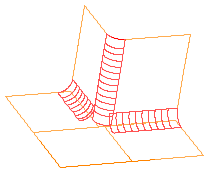For three or four surfaces, if you choose **Automatic as the curve to indicate that the system should automatically calculate the curve then the following restrictions apply:
- The fillet surfaces must extend to where they intersect with the other fillet surfaces. This figure shows an example of surfaces that do not intersect.

- If the surfaces are not a FeatureCAM-created fillet (either not a fillet at all, or an imported surface), the automatic corner boundary calculation may fail. In these cases it is better to specify the curve-on-surface for that particular surface.
-
FeatureCAM attempts to find a closed loop across the three or four surfaces by intersecting the rail curve boundaries of each fillet with the other fillet's rail curves. This figure shows rail curves.

- Therefore, if any of the curves on surfaces are specified, they must intersect with these rail curves of the fillet surfaces where a curve on a surface is not supplied.
- If a fourth surface is supplied, it is usually not a fillet surface. For these surfaces you must supply a curve on the fourth surface. The curve supplied must be on the fourth surface and should be tangent to the rail curves or the neighboring fillets.
- If the automatic calculation fails, try a bigger tolerance, supplying more curves on the surfaces or extending the fillet surfaces so that they intersect. Sometimes it is helpful to recreate the fillet surfaces with a tighter tolerance or a variable arc step.
General restrictions
- With only two surfaces, you must indicate curves on each surface to connect.
- For three sided cases, if there is a natural pole as in this image, it is best to put the fillet surface that is furthest from the pole as the first surface.
|
|
|

 - natural pole
- natural pole
 - use furthest fillet surface as the first surface
- use furthest fillet surface as the first surface